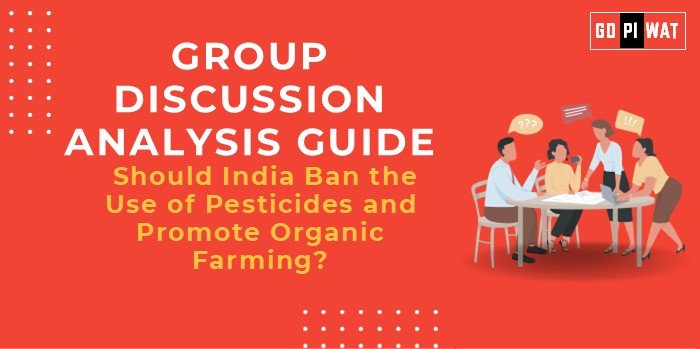📋 Group Discussion Analysis Guide: Should India Ban the Use of Pesticides and Promote Organic Farming?
🌿 Introduction
Context: Pesticides have been instrumental in India’s Green Revolution, enabling food security. However, concerns about health, environmental degradation, and declining soil fertility have reignited debates about moving toward organic farming.
Background: India is the fourth-largest producer of pesticides globally, but pesticide overuse has led to significant ecological and health crises, such as pesticide poisoning and contamination of water bodies.
📊 Quick Facts and Key Statistics
- 🌾 Pesticide Consumption: India uses 0.5 kg/hectare, significantly lower than China (13 kg/hectare), but excessive use in regions like Punjab poses severe risks.
- ⚠️ Health Impacts: WHO estimates ~3 million pesticide poisoning cases globally each year, many in developing nations.
- 📈 Organic Market Growth: India’s organic product exports grew by 38% in 2023, reaching $1 billion.
- 🌍 Land Under Organic Farming: ~2.78 million hectares, the ninth-largest globally.
🤝 Stakeholders and Their Roles
- 🏛️ Government: Policies and subsidies for organic farming; FSSAI regulates pesticide residues.
- 🌱 Farmers: Primary adopters of pesticide or organic practices.
- 🛒 Consumers: Driving demand for organic produce.
- 🌍 NGOs/Activists: Promoting awareness of sustainable agriculture.
- 🏢 Corporations: Developing eco-friendly alternatives like bio-pesticides.
🏆 Achievements and Challenges
✨ Achievements
- 🌱 Sikkim: Became the first fully organic state in 2016.
- 📜 National Program for Organic Production: Promotes certifications and exports.
- 🧪 Bio-pesticides: Now constitute 12% of the pesticide market.
⚠️ Challenges
- 🌾 Lower Yields: Organic farming has 20–30% less yield compared to conventional methods.
- 💰 Higher Costs: Certification and inputs for organic farming are expensive.
- 🔍 Consumer Trust: Limited confidence in organic labeling.
🌏 Global Comparisons
- 🇧🇹 Bhutan: Aims to be 100% organic.
- 🇪🇺 EU: Restricts pesticide use, promoting sustainable agriculture.
📚 Structured Arguments for Discussion
- ✅ Supporting Stance: “Banning pesticides can improve public health, reduce environmental harm, and enhance export potential for organic produce.”
- ❌ Opposing Stance: “Complete reliance on organic farming may jeopardize India’s food security due to lower yields.”
- ⚖️ Balanced Perspective: “A phased reduction in pesticide use with incentives for organic farming offers a sustainable transition path.”
🎯 Effective Discussion Approaches
- 📊 Opening Approaches:
- 🔢 Quote: “Sikkim’s success as an organic state proves the feasibility of scaling sustainable agriculture.”
- 📈 Data-Driven: “India’s pesticide consumption is lower than global averages, but localized overuse causes significant harm.”
- 🔄 Counter-Argument Handling: Acknowledge yield concerns but present innovations like bio-fertilizers and precision farming to address them.
🔍 Strategic Analysis of Strengths and Weaknesses
- 💪 Strengths: Health benefits, export growth, improved soil health.
- 🤔 Weaknesses: High input costs, lower yield, certification barriers.
- 🚀 Opportunities: Rising organic demand, global markets, bio-tech advances.
- ⚠️ Threats: Food security concerns, price volatility, limited awareness.
🎓 Connecting with B-School Applications
- 🌱 Real-World Applications: Opportunities for agribusiness projects, policy analysis, and ESG (Environmental, Social, Governance) initiatives.
- 📝 Sample Questions:
- 💬 “How can organic farming contribute to sustainability in agriculture?”
- 💬 “Evaluate the economic feasibility of banning pesticides in India.”
- 💡 Insights for Students: Explore how agritech can bridge the yield gap and ensure scalability.


